1972 Lotus Elan +2
Mike James always fancied the Lotus Elan +2 over a two seater so we put him in one for the day to find out why.
The List Reader Mike James tries the luxurious Lotus Elan +2 for size — but does it excite?
Does the Elan work as a GT? Reader Mike finds out
Though he has a string of classic British sports cars to his credit over the years, Classic Cars reader Mike James has never owned a Lotus. His wish list is a mixture of European classics, almost all of them with a sporting bent, but he’s most keen to try one of Colin Chapman’s British lightweights to try out the Lotus handling and performance that he’s been reading about for so long. Of all the Lotuses to pick from it’s the Elan +2 that has caught Mike’s eye. An unusual choice, perhaps, because the longer, wider iteration of the Elan with its extra couple of seats, introduced in 1967 and available only as a fixed-head coupé, has always lived in the shadow of the two-seat Elans despite the two cars having so much in common under the skin.
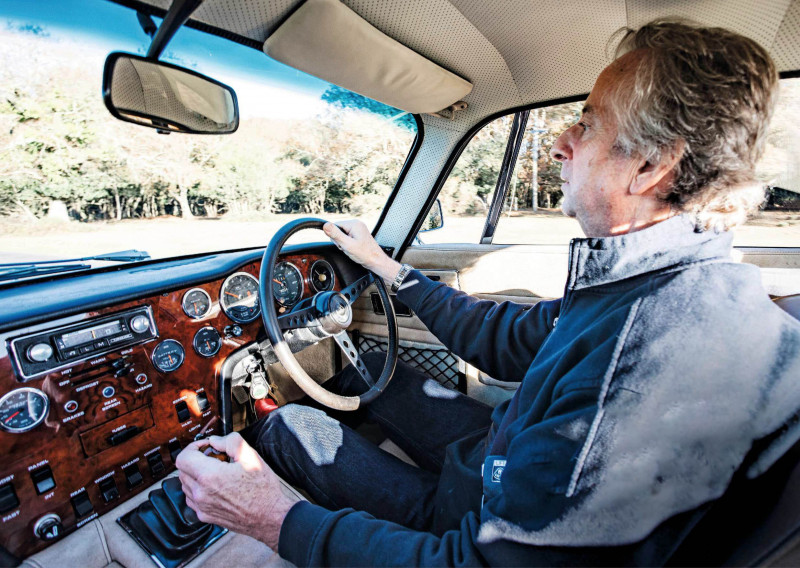
‘I looked up the price new. For a few hundred more you could have an E-type’
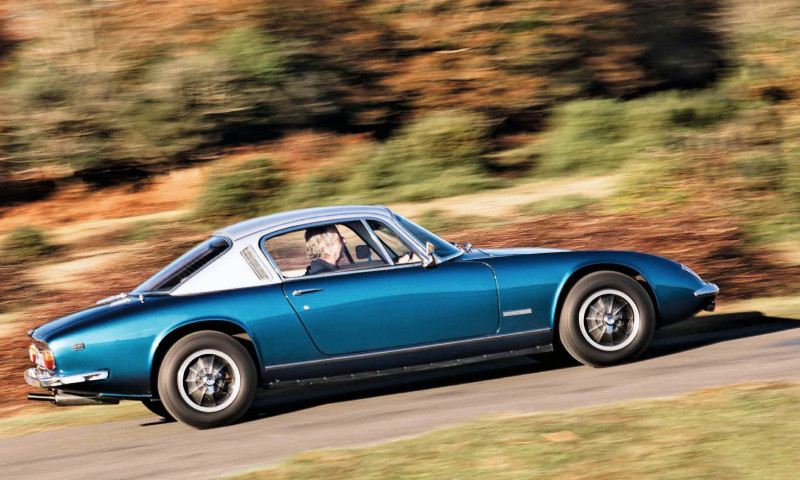
‘Is Lotus Elan handling really that good?’ Reader dream drive answers the question
The additional practicality appeals to Mike, ‘I looked up the price new and it was £2200 in the late Sixties. For a few hundred more you could have an E-type. Today £25k-£30k would buy a damned good example. I thought they’d be more than that, but it seems that in the Lotus world it’s not the desired model.’
In any case, we’ve tracked down an enthusiastic owner of just such a car, and arranged for Mike and the Elan to meet at the Royal Oak pub near Fordingbridge in Hampshire, close to some fine driving roads where hopefully man and machine will bond. We know we’re in the right place when we arrive to find not just one Lotus but three lined up outside.
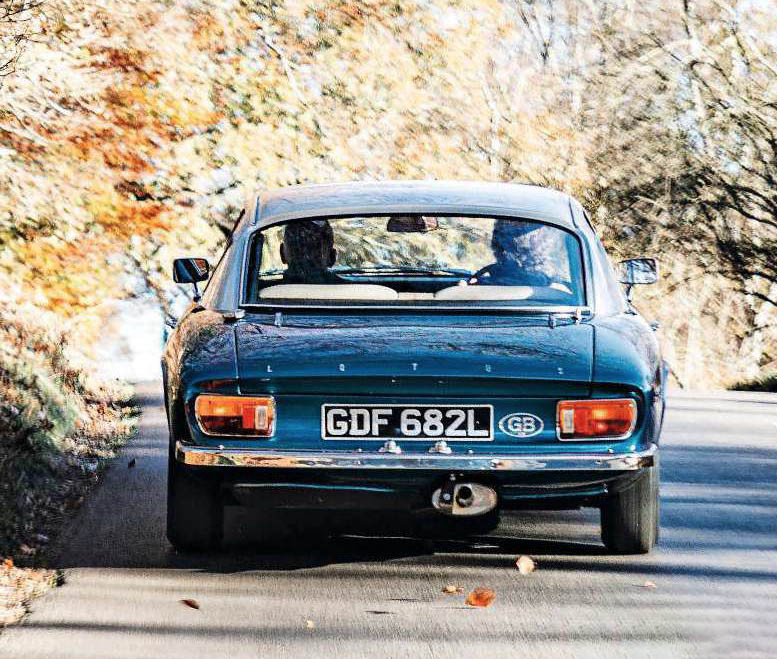
Elan +2 owner Simon Mears is there in his car, and he’s been joined by fellow +2 owner Mick Rouse and local Lotus club rep Ian Rymer who have come along to see us off. Mick’s own +2 and Ian’s red-and-white Elise are superb in their own right, but it’s Simon’s +2 that stands out thanks to a recently completed respray in the lovely original colour of Lagoon blue, with the common Elan +2 feature of a silver metalflake roof.
‘I’ve always been a Lotus enthusiast,’ Simon tells us after pleasantries have been exchanged. ‘I bought a Type 14 Elite in 1969 at the tender age of 19 and used it as a daily driver for many of the ten years I had it. I’ve owned an Elan Sprint drophead coupé for last 20 years and a Nineties front-wheel-drive M100 Elan – very much an emerging classic – for 15. The +2 was added to the collection more recently to complete a full house of Elans.
‘My wife Carol has always admired the +2, so convincing “mission control” that buying one was a good idea was pushing at an open door,’ Simon says with a chuckle. ‘We acquired the car in 2018. The main works undertaken so far have been the full body restoration and paint – a brilliant job by Honiton Bodyshop – and Sue Miller CV driveshafts. Soon I’ll be installing an Alan Voigts five-speed Ford Type 9 gearbox to replace the worn-out original four-speed. One day I will install new carpets, because the oatmeal is so hard to keep clean.’
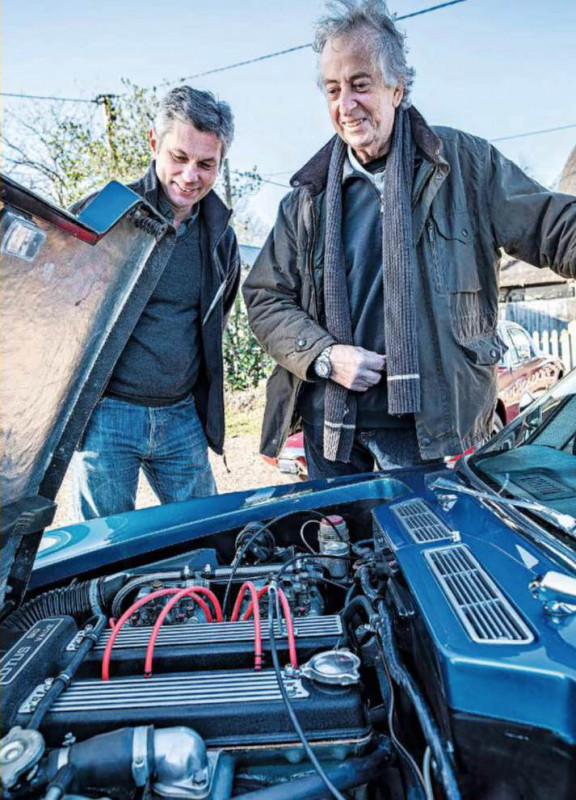
Reader Mike is soon poring over the Elan, chatting with Simon as he takes in the details of the shape. ‘It’s great to get this close to one,’ he says. ‘It’s just as attractive as I thought. The cheeky curves of the original Elan were sharpened up to give the +2 a more grown up and sophisticated character, and the result is a beautifully resolved sports coupé.’
Under the forward-opening bonnet there’s the familiar Lotus Twin Cam engine, complete with a newly-painted crackle-black cam cover. Though his previous classics have generally had six or 12-cylinder engines, Mike has nothing against a well-prepared four. ‘It doesn’t bother me,’ he says. ‘I’m just interested in how it performs. But the engine is nice looking, if that’s what matters to you – it looks like it should be well sorted.’
After folding his six-foot frame in through the door and settling into the oatmeal bucket seat, Mike is soon enthusing about the cabin. ‘It’s bigger than I thought it was going to be,’ he says. He has plenty of legroom, headroom and shoulder space, far more than is available in the shrink-to-fit two-seater Elan, not to mention the extra seats behind. ‘I’m sure there’s more room in the back than in the 2+2 E-type I had,’ he says.
There’s praise, too, for the well-thought-out arrangement of seat, steering wheel and controls. ‘The driving position makes you feel like you’re in a sports car. You sit low and I know it’s a cliché but it really does make you feel like you’re part of the car.’ Ahead there’s a business-like leather-rimmed wheel with drilled alloy spokes and a handsome walnut-veneered facia that’s well stocked with Smiths instruments. ‘All these dials on the dashboard – that’s what everybody wanted,’ Mike says. Then his eye catches something unusual, and he leans forward for a better look. ‘There’s an outside temperature gauge,’ he exclaims. A voltmeter and a clock, too, plus separate gauges for oil pressure and coolant temperature – all denied to the two-seater Elan, which had just a combination oil/water gauge in addition to the basics. ‘It all helps to underline the +2’s status as a more upmarket model in the Lotus range in the Sixties. This car would have cost 20 percent more than a two-seater Elan back in the day, which was a fair chunk of money.’
Mike scans the rows of big, black rocker switches lined up along the dash, labelled in the Microgramma font that was the epitome of technical aesthetics in the early Seventies, from Gerry Anderson TV shows to the then-new Casio logo. ‘There are hazard lights, a map light, electric windows, and there are even puddle lights in the bottoms of the doors,’ he says. ‘How many cars of this era had all that? I didn’t realise it had all these features. I can’t remember any other car of the era that had all this stuff – it would have been a big deal at the time, I think. They are the kind of features a salesman would have been pointing out and using to clinch the sale during a test drive. He’d have been saying, “You won’t get all this in an E-type, those are a bit old fashioned – this is the way the world’s going.” Not that all the equipment was necessarily very useful – would you ever use a map reading light? Maybe once a year. But it looks good.’
It’s time to get the Lotus started and take to the road, and Mike heeds Simon’s advice not to touch the accelerator pedal while turning the engine over. There’s no need, because a modern electric fuel pump feeds the big twin Dell’Orto carburettors and the twin-cam four-cylinder needs little encouragement to get going. It fires up eagerly, emitting a throaty rasp from those four big intakes. With that Mike heads out to find some challenging New Forest curves to test the +2’s mettle.
‘It’s easy to drive, and it doesn’t make me think I should just stay in second or third gear while I get used to it, like I would in a lot of cars,’ he says. ‘I don’t feel that at all. It makes you feel at home straight away.’ The good-natured delivery of the lusty motor helps, too. Though maximum torque doesn’t arrive until 5500rpm it’s still strong in the middle of its rev range, which helps to make the +2’s performance all the more exploitable.
‘I’m finding it very responsive,’ Mike says. ‘The acceleration is noticeably good by the standards of those times. Everybody looks at 0-60mph times but nobody ever does that in the real world. The Elan is particularly good in that 20-40mph or 30-60mph overtaking range when you put your foot down. That’s what matters in the real world. Compared to the E-types I’ve had, you can definitely feel that it’s lighter.’
In these first few miles Mike has already identified the worst aspect of the Elan experience – the vague quality of change of the well-worn gearbox, which owner Simon had already warned us about. ‘Once you’re in fourth it’s fine, but the gearchange is graunchy. You wouldn’t put up with it for long,’ Mike says. ‘It’s no wonder Simon’s planning to replace it.’
Mike is revelling in the agility and suppleness of the Elan as it carves through the bends. Handling finesse is a key part of the car’s appeal, and Mike reckons precision is at its core, ‘You point it, that’s where you’re going to go. Not approximately, but dead on. That’s what Lotus was all about,’ he says. ‘It feels much more modern than my ’Healey, which is a 1954 design. The ’Healey is heavy when you’re doing three-point turns. I wouldn’t imagine taking your driving test in one would be the finest thing in the world. ‘In contrast the Lotus steering is pleasantly light and you can feel everything through the wheel.’ It turns out that the steering also has another, more surprising quality too, ‘The turning circle is amazing. Maybe not quite up to the standards of a London taxi, but coming along that way.’
The Elan’s tidy road manners are backed up by excellent ride quality, a combination that Mike reckons would make it a fine touring machine. ‘I’d drive from the south coast to Scotland in it and think nothing of it,’ he remarks, deadly serious. ‘It’s comfortable enough, and by sports car standards it’s not too noisy. For touring it’s also a plus that there’s a lot of room in the boot. In my ’Healey the boot is useless and I think even the E-type didn’t have as much luggage space as the Elan +2.’ As our time with the Lotus comes to an end Mike reflects on the experience. It’s clear the Elan has made a big impression. ‘It really was as good as I’d hoped. It was easy to get into and drive straight away. It was responsive – you touch the pedal and you’re off. I didn’t hear any rattles over the bumps, which was very different from my ’Healey where there are quite a few rattles.’ Despite the received wisdom that Lotus reliability can be less than perfect, Mike insists the Elan +2 felt dependable, ‘They might be sensitive or unreliable or whatever, but it didn’t seem it to me. It was on the button and seemed as solid as a rock throughout the day,’ Mike says. ‘It could be just that this car is a good example, or perhaps people have exaggerated things over the years for the sake of a story.’
So, the million-dollar question – does the Elan keep its spot in Mike’s top 10 dream cars? ‘It certainly would still be on the list. I haven’t driven the others but I would probably move it up a few places in the pecking order,’ Mike says. ‘It’s a really drivable car, you could live with it, and for its day it would have been a real pocket rocket. Yes, I’d definitely buy one.’
TECHNICAL DAT 1972 Lotus Elan +2
- Engine 1558cc inline four-cylinder, dohc, two Dell’Orto DHLA40 carburettors
- Power and torque 126bhp @ 6500rpm; 113lb ft @ 5500rpm
- Steering Rack and pinion
- Suspension Front: independent, wishbones, coil springs, telescopic dampers, anti-roll bar. Rear: independent, wishbones, Chapman struts, coil springs, telescopic dampers
- Brakes Servo-assisted discs all round
- Performance
- 0-60mph: 7.5seconds
- Top speed: 120mph
- Weight 864kg (1905lb)
- Fuel consumption 25mpg
- Cost new £2573
- Classic Cars Price Guide £10k-£27.5k
Generous space and fine driving position makes cabin welcoming Writer Noakes (left) and reader James marvel over +2’s well-stocked dash .
Decent size boot makes the Elan +2 surprisingly practical
Lotus driving agility and everyday usability key to Elan +2 appeal


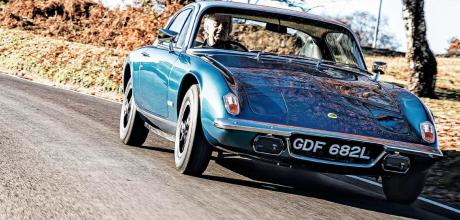
Hi Mike
I read this article with great interest, as I owned this very car a decade or so back. It looks excellent and I am more than a little envious. Hope it’s going well for you. I’d love to see it again at some point. Maybe see you at a car show or similar. Cheers!
Ian